
How’s your summer going?
Mine was going pretty well, thank you. Well, it was…until yesterday,
That’s when I received an onslaught of emails from several industry friends, colleagues, and JacoBLOG readers. These communiques persuaded me to shelf the post I had scheduled for today. Instead you get this one.
The first story was emailed to me Monday from a publication called The Drive. The title doesn’t mince words:
“Automakers Are Starting to Drop AM Radio in New Cars. Here’s Why”
Written by James Gilboy, the story touches on a disturbing trend I’ve written about in this blog – that electric vehicle makers have moved away from AM radio.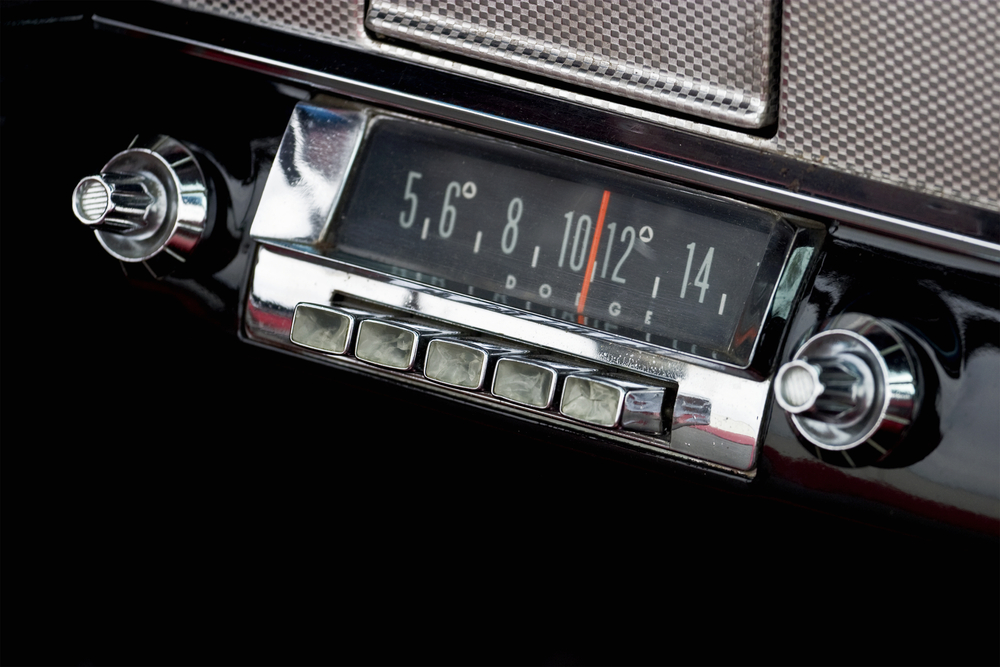
But it’s not across the board. Some of you recall BMW eliminating AM from some of its models a few years ago. And more recently, Tesla has been leading the charge.
And yet, it’s a fact that Ford will continue to include AM radio in the dashboard package on their all-new F150 Lightning EV trucks. How are they getting around the so-called “interference problems?”
 By installing a whip antenna (pictured, yellow arrow) on these cool new vehicles. Some believe Elon Musk and other car makers aren’t keen about the aesthetics of these old school antennas, instead opting to deep-six AM radio altogether.
By installing a whip antenna (pictured, yellow arrow) on these cool new vehicles. Some believe Elon Musk and other car makers aren’t keen about the aesthetics of these old school antennas, instead opting to deep-six AM radio altogether.
But Gilboy goes a step further in explaining why some EV automakers are retaining AM while others can’t drive away fast enough away from it:
“We contacted all three of Detroit’s giants for why they continue to include AM radios when some European makes have phased them out, but the answer establishes itself across those very same lines.
“AM radio has fallen out of favor in Europe, with Radio Info reporting in 2015 that stations were shutting down en masse from France to the Netherlands and Russia. The frequency has largely been superseded by the DAB format, which is a more advanced form of radio broadcasting with better audio quality and choice of stations.
“AM radio stations and their listeners are all but gone in Europe, so European carmakers may not need to include technology that many of its customers can’t use.”
AM radio has lost its luster here in the States, too. In Techsurvey 2002, we ask those in the market for a new vehicle in this calendar year to check off the media features they find most important in their next car. This year, FM was edged out by Bluetooth for the first time ever. AM, however, is well down the list of key priorities, deemed important by only one in three.
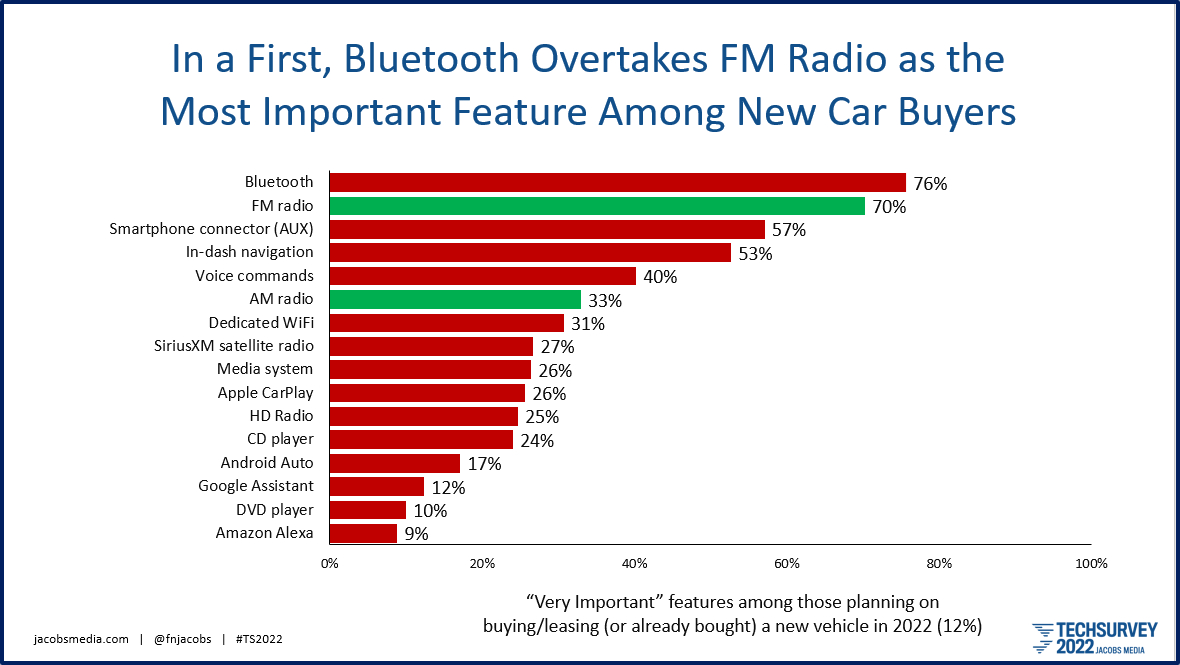
Still, when you’re in an industry that sells roughly 17 million new vehicles each year in the U.S., that would come to a lot of pissed off AM radio fans. Hence, vehicles made by GM, Ford, and Chrysler are likely to still receive WGN, WABC, and KOA. At least, for now.
But it’s a bad sign when EVs from Audi, BMW, Porsche, Volvo, and Tesla are rolling out of dealerships – sans AM radios. As Gilboy notes, however, “even some hybrids are abandoning (AM radio) technology.”
If you’re a broadcaster with AM stations that still matter in your portfolio – strong brands with heritage that throw off revenue – the writing that’s already been on the wall is being etched in stone.
And owners of FM have no business being smug that these moves are being made on AM. This is an anti-broadcast radio trend, make no mistake about it.
And that leads us into the second story.
Just after noon yesterday, a number of you sent me this subtle graphic – an ad from our friends at SiriusXM, sent via email and served on Facebook.
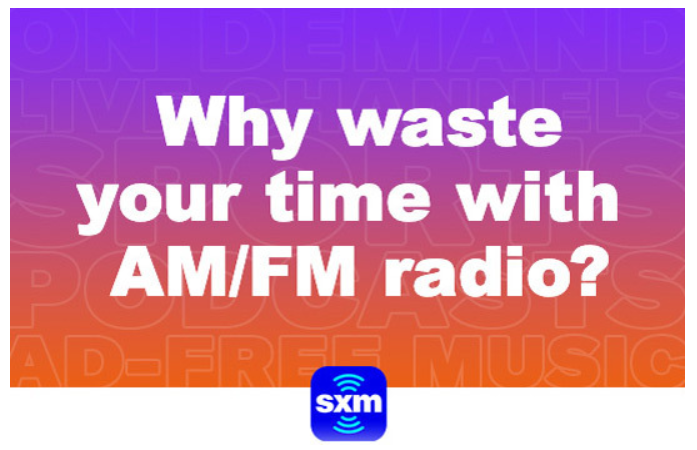
No bones about it – it’s always been highly competitive – especially in the eyes of the sat rad companies and those who have worked for them over the years. Shockingly, however, I’ve heard many, many broadcasters write them off and dismiss them over the years, despite their many attractive features and aggressive programming forays.
Howard Stern may be the most high profile of broadcast radio people who defected to Sirius and XM. But behind the scenes, many of the programming people and personalities working for SXM first made their names in radio on the AM and FM bands.
You may remember some of the early ads:
“There’s AM, there’s FM…and there’s XM.”
Very smart and clever – a way to differentiate what was then a new product on the market: subscription radio, something that had not been done before.
Fast-forward a couple decades and we’re living in a different audio world now. SiriusXM is now one company (don’t get me going on how that marriage was sanctioned), and is one of many audio options, alongside streaming, podcasts, and of course, broadcast radio.
Techsurvey 2022 shows that roughly one in four of our respondents – mostly core radio listeners, as you know – subscribe to SXM – or are getting in gratis when they bought or leased their vehicle.
But the deeper dive reveals that when customers buy a new “connected car” with an infotainment system such as Ford SYNC® or Audi connect®, they end up listening to less broadcast radio and more SXM. We think a big reason for that is the similar experiences offered by both – scanning, presets, and overall sound. SiriusXM channels are most similar to terrestrial stations – by design.
And my least favorite slide in Techsurvey – the one that asks satellite radio subscribers how their AM/FM listening has changed since they acquired SXM:
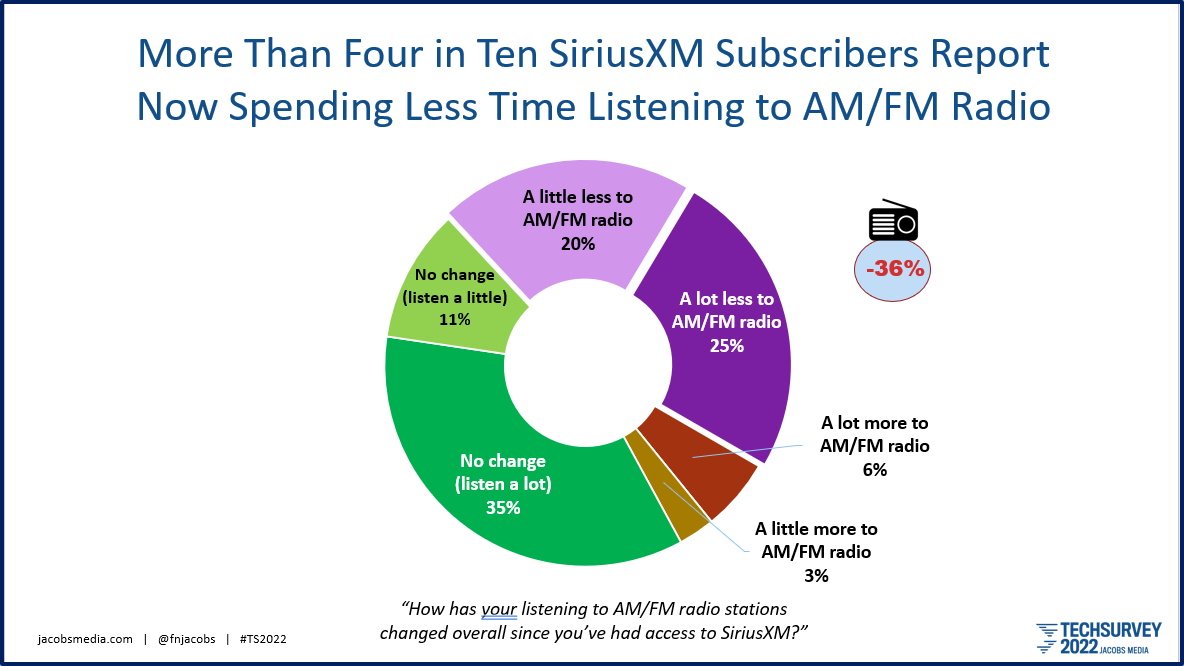
It’s substantial. Nearly half (45%) of satellite radio subscribers spend a little/a lot less with AM/FM radio as a result. That little “bug” on the right shows a net loss of 36% when all is said and done. That should tell you all you need to know about which of radio’s competitors is a clear and present danger.
And so here we are – an old school industry whose best days came in the era of VCRs and dial-up Internet. Today, radio broadcasters are surrounded on all sides by new technologies like on-demand, streaming, podcasts, and whatever’s next. (Are we likely to listen to radio in the metaverse? No.)
This direct attack by SXM will likely not be parried or countered by any of the players in the radio broadcasting business. The NAB and RAB have its collective hands full, and most broadcasting groups aren’t exactly on the same page.
As I’ve talked ad nauseum in this space, the last thing today’s owners of radio stations do is speak with one voice. Instead, each is pursuing their own game plans, operating more like separate fiefdoms rather than as a unified force with a great deal at stake.
SiriusXM, Spotify, and most of radio’s new media competitors are single, self-contained entities, able to crank out strategic marketing campaigns like the one that graced so many of our in-boxes and social pages yesterday.
Sadly, many of you don’t know the full extent of SXM’s challenge because you lack the research and resources necessary to fight the good fight. This is another reason why we will continue to focus our efforts at Jacobs Media on providing radio broadcasters with data broken down by format for your individual stations in your home markets.
This year, we introduced a new series of questions that takes a deeper dive into the SXM channels format fans go to most when they switch away from your music stations. We will continue to trend this data, as well as provide positioning and marketing responses and solutions.
Yet, it still comes down to the industry captains putting aside their differences to create a task force that tackles this new competitive environment. We need sessions at upcoming conventions that address these competitive salvos, and provide actionable ways in which stations can fight back.
Radio also needs to think about its two most important constituencies – advertisers and audience – both of whom are susceptible to a strong marketing message.
Meantime, I’m going to take a chill pill, reapply some sunblock, and order another of those tasty umbrella drinks. After all, I must have a little PTO coming, and at Jacobs Media, it’s use it or lose it.
The old me would’ve been bent out of shape by this latest SXM assault, firing back with some sharp-tongued vitriol of my own. But that was the old me. Now, I’m living my best life, taking things in stride, keeping my powder dry. When they go low, I go high – right for the jugular.
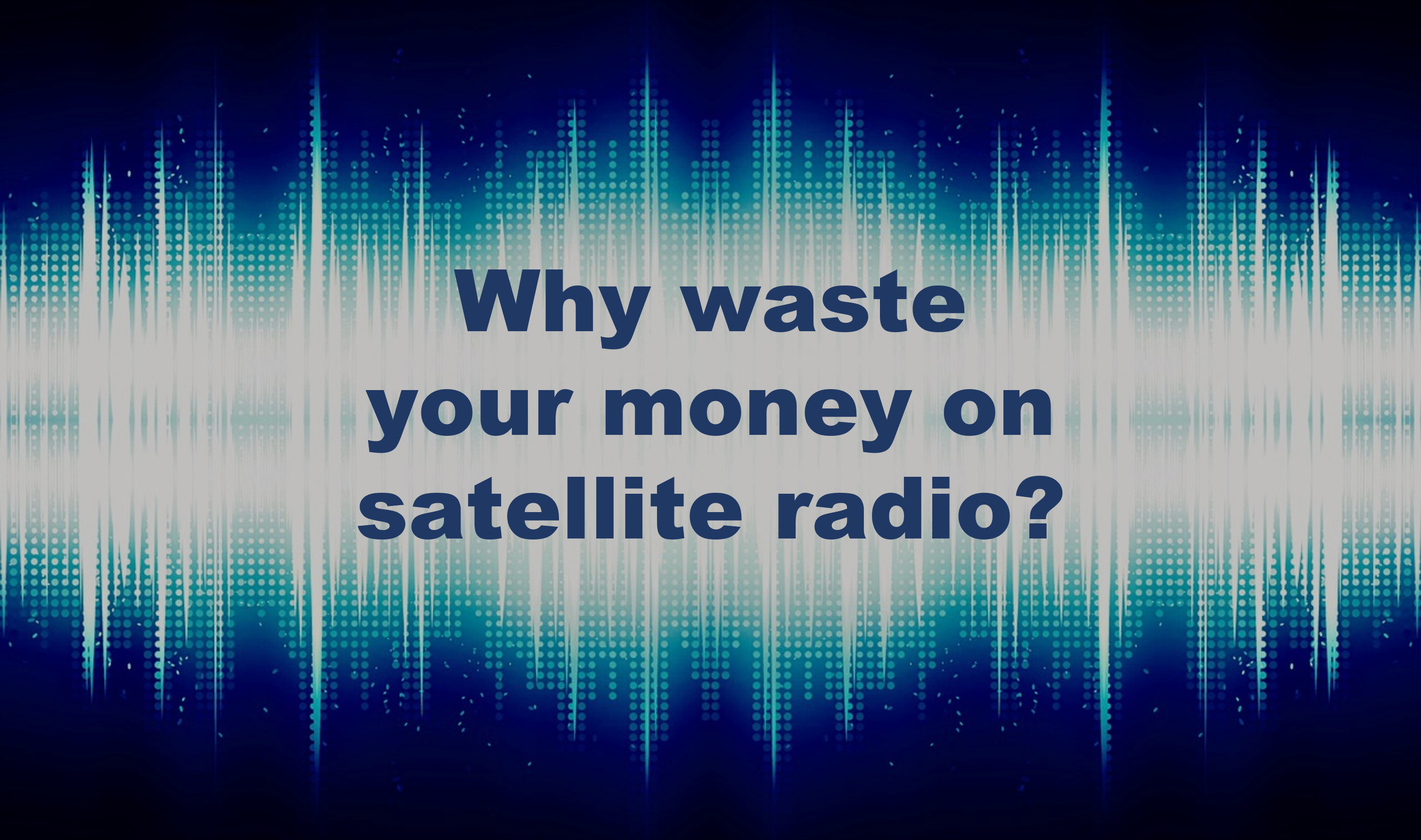
Thanks to Steve Schram, Scott Jameson, Ken West, and Marty Bender.
- Media And Technology In 2025: Believe It Or Not! - April 18, 2025
- In Radio, You Just Never Know - April 17, 2025
- The Secret To Making A Great Podcast (And Great Radio) - April 16, 2025




It’s all about content, connection, presentation and local service. AM provides a licensed delivery that’s broadcast, fed and enhanced with digital, everywhere!
Fred,
Hope you don’t mind…
https://www.facebook.com/wisconsin106
C U @ MSBC!
With so many of the big broadcasting companies losing timely local content and presenting more and more generic content the only difference between satellite and OTA radio is ad content and subscription costs. SXM also bombards you with promotion and will drop prices to a very affordable number to offer a plethora of content that’s unmatched by OTA radio. Streaming services like Spotify, Pandora, Amazon, and Apple are now in the mix thanks to Bluetooth phone connections. Radio MUST take advantage of its strength – relevant and timely content tailored to a local audience – promoted appropriately with limited advertising that actually informs and entertains.
OTA terrestrial radio also has a couple of advantages that make a difference to many listeners.
– The audio quality, particularly in HD Radio, is superior to any of the competition except, possibly, CDs (a dwindling competitor). Audiophile do exist and do care. Mentioning this will draw their attention to a fact they can’t unknow.
– The inherent robustness (and simplicity) of the audio chain from the receiver’s point of view. When the internet’s down or your phone’s out of charge, or you can’t afford the data, OTA radio is there to greet you. Sure, SXM has the same robustness, but the audio quality is still lame and they can’t offer your local talent and information.
Seize these advantages. Let your listeners know, and enlist their assistance shaping the perceptions where they live.
Why anyone would pay for SXM is beyond me when there’s a plethora of free streaming services out there and most vehicles come with blue tooth these days is beyond me.
The only reason I can think of is that SXM still has on-air talent and people still want a familiar voice in the car talking to them.
To me, this is where the research needs to be directed. And also where radio needs to pay attention. Live jocks are still the key to radio success.
Why? Because I like the variety on SXM and I like how easy it is. Have I worked at a public radio station for 25+ years? Yes. Do I need a break from 24/7 news? Yes. Do I avoid AM/FM music stations because of the ads, and sorry folks, often the hosts/DJ? Yes. Does SXM offer variety without me doing the legwork to find it? Yes. Do I have the same familiar choices no matter where I am through the SXM app? Yes. Am I promised a consistent listening experience when I have a rental car? Yes. When I evaluate my media choices and my budget, do I feel like the ROI is there to pay for SXM? Yes.
Craig, talent, convenience, and inertia play important roles in explaining why one would subscribe to SXM.
First, AM radio. Only 1/3 of new car buyers care – that’s probably not enough to justify a whip antenna, except maybe as an option buyers pay for. There are probably only 15-20 AM stations that matter and I’ll bet in almost every one of their company’s clusters there’s a POS FM with a 2-something share that could run the AM’s programming with little or no financial loss to the cluster.
AS for Sirius/XM and how do combat it. First, be glad that their programming, particularly on gold-based stations really isn’t all that good. It smacks of 27 year old’s programming music that was released when they were in diapers or not yet born, without a sense of what fits and what doesn’t.
As for speaking with one voice, I remain adamantly opposed. First, this isn’t a problem that can be solved with a savvy marketing campaign or two. Radio defection is more product based than image based – and to the extent that radio is addressing that with one voice, its going in the hub and spoke direction. The ad could read, “Radio – its like free Sirius FM with a lot less choices and a boatload of commercials.”
IMO, radio must address all of its competitors one station/market at a time. If a radio operator wants people in Detroit to listen more to its stations and less to format competitors on Sirius, it’s up to each local station to leverage its built-in advantages to make it happen. I’d really be interested to see if people were listening to less satellite radio in markets with strong radio stations in given formats. What’s the “listen more to Sirius/XM”) number like among classic rock listeners in places like Philly, Detroit, Cleveland and Pittsburgh, where there are long standing top rated classic rock stations?
I can’t believe I’m actually going to say this, but the way for radio to minimize defections to satellite radio and other competitors can be found in the words of Melania Trump…”Be Best!”
My friends all know I am a radio programmer, and the ones that have gone to SiriusXM (both separately and together) in the past have always been apologetic to me over it …
… and then come back to me a few months later asking me why they are hearing a lot more songs they don’t care about and why they aren’t hearing as many of the ones they DO care about as often. To put it the way one friend did: “I thought that if I paid for a service like this, it would play all my favorite songs and I’d just be avoiding the commercials. Why am I paying for THIS?”
All I could answer was: “I don’t know. Why ARE you paying for it?”
We’ve all seen the research. It’s the same regardless of format — Classic Rock, Classic Hits, CHR, AC, Country — audiences want (and EXPECT) to hear some of their favorite songs, no matter what medium they choose to listen via. What they DON’T want is a lot of songs that the programmers like but that they do not.
I believe the answer is: We need to trust the research, offer very focused playlists focused on what our listeners want, and then promote the hell out of it.
SiriusXM asks “why are you wasting your time on AM & FM”? We should be asking “why are you wasting your time on satellite listening to a bunch of songs you don’t want to hear?”
As for AM: I’m lucky enough to have an older EV (Smart 2015) which, even though manufactured by Mercedes-Benz’ parent company, was engineered to make AM reception not susceptible to the interference caused by the car’s operation. (In fact, I think AM reception in my Smart is better than in most non-EVs whose radios I have encountered.) Sadly, here in L.A. the 540 to 1700 band is largely non-English language or talk, neither of which I care about. And our one news station, KNX, started simulcasting on FM, displacing a CHR that had been hemorrhaging listeners for years … so, to modify that SiriusXM ad, “why am I bothering with AM?” I’m not, and it has nothing to do with reception. Maybe AM is destined to be relegated to the ethnic and “blah-blah-blah” formats. Does that mean the band shouldn’t be available in cars and trucks? No, but it does mean that fewer and fewer automotive buyers will care whether or not it is.
(Sorry for not being around to comment for the past couple of weeks, Fred. Been dealing with some important, but not life-threatening, medical issues, as well as doing the advance work for an important station launch in September.)
Great to hear from you, K.M. Hope everything’s OK. Thanks for the first-hand satellite radio lessons.
I subscribe for THAT reason. To hear songs terrestrial radio won’t touch. If I wanted to hear the same songs over and over, why waste money on satellite radio? I WANT wide, and deep playlists. When some tighten up on XM, I move on.
Mark, I hear that from a lot of people. Some feel there’s variety (if you surf enough channels), while others find it strangely repetitive.
Another thing to remember about Sirius XM is that it hasn’t been *just* a satellite-radio company for some time; it now has significant holdings in streaming (Pandora) and podcasts (Stitcher). While I think that those purchases were a good idea (at least, in a general sense), I also recognize that they’ve made the company into even more of a competitor to broadcast groups.
Likewise, since Sirius XM has moved into those fields, broadcasters also need to reexamine their approaches. I’ve been occasionally revisiting a piece that WFMU’s general manager did for RW in June about how streaming/online playlists have become integral to both the station itself and its overall brand–which ends with…
“But the people who hang out on our playlists and chat all day are not representative of the typical radio listener. These people are a subset of our P1 listeners, a focus group, a peanut gallery, a fan community, depending on which of our DJs you discuss it with. The playlist and the chat may not represent the totality of our radio audience, or the full craft of radio, but it provides radio with the real-time community and interaction that younger listeners now demand.”
https://www.radioworld.com/columns-and-views/guest-commentaries/radio-in-the-age-of-playlists
You make so many good points.
I love that quote from Ken Freedman. It speaks to “why digital,” and the ability to grow a brand, a footprint, a fan base. Depending on the consumer, some of these tactics will work, others will fail, and still otherss will be on the ledge.
As a programmer, you have to decide where to play your bets…and what to walk away. This is a dynamic that will play out over the next several years. Thanks for this.
HAD to jump in on this one Fred. I grew up with AM and my first Arvin 7 transistor radio that went absolutely everywhere with me. Of the 45 radios I own, they ALL have AM, but just yesterday trying to listen to WJR’s 50 kw signal in my car, it was filled with so much static from nearby power lines, it was barely audible! I’m often required to tune in the stream on my iPhone which, because of the age of my 2005 vehicle, enters my car radio via a cassette adapter with a wire attached! Too old for either an AUX jack or Bluetooth. In Detroit there are really only TWO relevant AM’s, talk WJR and news WWJ. At the rate Audacy is adding FM’s to heritage AM’s in many major markets, I’m sure WWJ will soon have a full-market FM and I’m pretty sure I know which one it’ll be. Then Cumulus will be forced into surrendering one of their two FM signals for WJR. However, I have to say in a friends new Tesla, I experienced the absolutely BEST reception on both AM and FM that I have ever heard!
Art, I think you are right that there are “FM homes” waiting for some of the better, most profitable AM stations. And if I was one of these broadcasters, I wouldn’t wait until the end when most listeners will be gone. I believe the smart money will be in flipping them now (or soon). Thanks for this.
LOL – it actually makes me laugh. Don’t forget how many right wingers there are out in the boonies who thrive off of the hate spew in AM talkers. Might really put a dent into those numbers!!
A lot of radio dollars has been made on the right, especially by Rush and his acolytes. I’m convinced it could be done from the left. Thanks for the note.
Stop worrying. Electrics make up a very small number of new car sales and will for a very very long time. That aside the survey shows Am above paid paid XM/sirius radio so again its still a contender. Yes the younger audiences opts for plugging mobile devices into stereo and playing self made playlists, but older people who like talk radio continue to listen to talk radio.
One further possible reason Am and FM will continue to shrink: When 2020 hit traditional radio/TV stations pushed the “acceptable covid narrative” and denied any talk that countered it, with a few exceptions. When we saw this take place, many of us went off radio and onto podcast/private video networks for our content. Who needs 10,000 stations proclaiming the same propaganda when you can find true independent journalists unafraid of blow back by advertisers and GM’s.
Some food for thought.
Very best, Steve Johann
Steve, thanks for this. I agree that EV ubiquity is a years away. But radio has taken that same “wait & see” (or “wait & do nothing”) approach with many technologies over the past couple of decades. I do this – 2030 will be here before we know it.
I’m a radio guy. But I live in a small college town and local radio is controlled by 2 groups. One is live and local, the other is anything but. So I get SXM for a mere $6/month. Radio will never win the commercial wars in this space. Radio COULD adjust its playlists. There is little that surprises any more. Features, anniversaries, current events – these could all prompt the playing of a song that is familiar but did not hit the mandated test threshold. That said – personality is they key. SXM does have a lot of boring ones. They also have some amazing and interesting performers. Someone like Elizabeth Cook on Outlaw Country. There are more on a variety of channels. There is more of an attempt on SXM to provide that element that is sorely missing from so much of radio. Your own tech survey pointed this out – people listen for personalities. Radio needs more of them.
I have some favorites on SXM as well. They should remind commercial broadcasters about why consumers value personalities. As you note, they may not execute all the time, but they’re going for it.
Great read! I don’t understand why anyone would pay for XM. Seems like Spotify or Pandora provide the same thing but free and better. So far the commercial load on Spotify is tolerable but with both of those I can pick my favorite music, put it in a playlist, I never have to hear a song I don’t like but if by chance one pops up I can skip it and no dj’s voicetracking about a city they’ve never visited. I still believe in radio but local, local, local is the only thing that will win. Right now its highly processed and imaged up, promoting the next element every break, corporate contests. The listeners are smarter than they’ve ever been and deserve better than what radio is serving up to them.
Kim, thanks for this. As you know, I’m a big believer in local, too. Listeners are smarter. They’re also bored. We have to provide better experiences.
How about a simple “Thanks” and “Bravoi” !